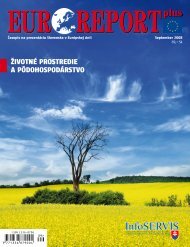stavebnÃctvo, výstavba a regionálny rozvoj - EUROREPORT plus
stavebnÃctvo, výstavba a regionálny rozvoj - EUROREPORT plus
stavebnÃctvo, výstavba a regionálny rozvoj - EUROREPORT plus
You also want an ePaper? Increase the reach of your titles
YUMPU automatically turns print PDFs into web optimized ePapers that Google loves.
SUMMARY<br />
Excerpt from an Interview with State<br />
Secretary of the Ministry of Construction<br />
and Regional Development of the<br />
Slovak Republic, Zsolt Lukáč<br />
The European Union funds being so<br />
much expected are avaliable at last.<br />
Which Slovakia’s regions are of priority<br />
for the Slovak Republic and which<br />
are for the European Union? Is the<br />
development of regions viewed in a<br />
different way?<br />
We do not share the same viewpoints. The<br />
European Union is evaluating the destination<br />
of support in compliance with statistical unit<br />
and in Slovakia there are four statistical<br />
units at the present, i.e., the east, the west,<br />
central area and the district of Bratislava.<br />
There were four units of priority determined<br />
for 2004 to 2006, notably all regions except<br />
of Bratislava region.<br />
Under the starting stage of support, the<br />
matter is to liquidate differences between<br />
the regions and those being mostly in behind<br />
are backed up first. District of Bratislava<br />
takes the second place after.<br />
It goes without saying that regions of<br />
Košice and Prešov are extraordinarily in<br />
need. Next, we’d like to back up the regions<br />
mostly in behind in the south of central<br />
Slovakia. Notwithstanding, our requirements<br />
and ideas still differ. First comes first.<br />
The European Union follows primarily the<br />
statistics on unemployment rate, scope<br />
of income of inhabitants, standards of<br />
education and those which are on the move<br />
now report significant differences from<br />
district of Bratislava.<br />
In other words, projects of these regions<br />
are of priority and this is the way how terms<br />
and conditions and criteria have been<br />
determined. We are interested in preparing<br />
sound projects within the framework of each<br />
region being provided with the European<br />
Union funds in order to use the funds<br />
accordingly. We intend to have the projects<br />
applicable. Many of them are being financed<br />
in combination with other local, regional<br />
and/or state resources.<br />
What is the application standard<br />
like? What sort of principle is being<br />
applicable? Towns or villages are on<br />
the move?<br />
Application standard is much better in<br />
comparison with those of pre-accession.<br />
Projects and applications for financial<br />
support from the structural funds have been<br />
developed better due to numerous reasons.<br />
We made every endeavours to promotion<br />
and awareness of public and potential<br />
applicants. We have been preparing the<br />
themes being fully involved in any aspect of<br />
the projects. And we really did a huge job.<br />
Let me mention that any project is being<br />
developed in compliance with the Slovak<br />
legislation. In pre-accession projects<br />
there had to be followed other<br />
legislative standards and legal<br />
rules than in current ones.<br />
72<br />
How is the entire procedure of<br />
approving the projects functioning? Is<br />
it really transparent?<br />
The system is functioning as follows: For<br />
a certain period of time there is a specific<br />
amount of applications and projects<br />
submitted to the ministry, being classified<br />
afterwards. Subsequently, each project is<br />
being assessed whether it has got all the<br />
requested formal essential elements, it is<br />
being completed and reviewed. Afterwards,<br />
the project will be sent to specialised<br />
assessment experts who will review whether<br />
the project is in compliance with the rules<br />
and determined priorities. In the same<br />
way each project is being reviewed from<br />
technical point of view whether it complies<br />
with all the required essential elements and<br />
then it is also evaluated from the financial<br />
viewpoint, notably whether the business<br />
plan and/or financial plan of the institution<br />
is covering the burden, whether the project<br />
can be implemented and also whether<br />
the respective entity is solvent sufficiently<br />
because the European Union funds are just<br />
the complementary resources and they do<br />
not cover the project in its entirety.<br />
Has it already happened that some<br />
projects from pre-accession funds were<br />
of short existence?<br />
Yes, it has. And that is why we want to<br />
avoid it. Thus, we follow mainly whether<br />
the project is sustainable and whether the<br />
respective entity has sufficient amount of<br />
funds available, either resources of their own<br />
or combined of numerous funds.<br />
How are the Regional development<br />
agencies functioning? How do they<br />
enter the procedure of project<br />
preparation?<br />
Regional development agencies have been<br />
functioning since 2000 and I think that it was<br />
a smart idea. And not because of the fact<br />
that it was our ministry which has introduced<br />
them. The ministry has financed partially<br />
their activities with the aim to introduce<br />
know-how and relevant information in the<br />
regions. And notably with the aim to make<br />
any information available to public sfere.<br />
The agencies are partially financed from<br />
ministerial resources and the ministries<br />
expect that the agencies will support public<br />
sector free of charge. I appreciate very much<br />
an approach of development agencies as<br />
they played an important role in quality<br />
standard of filed motions and applications.<br />
Respective staff is highly qualified and in<br />
locations and districts where the agency<br />
performs there were sound projects born<br />
and anybody is satisfied who is seeking for<br />
required information.<br />
So thus, it was just the plain hullaballoo<br />
that we were not ready to withdraw<br />
the European Union funds and huge<br />
amount of Eur would be of waste?<br />
If we did not launch such a vast campaign<br />
notably in last two years, the forecasts<br />
would come true most probably. There was<br />
a certain threat that regions would not be<br />
able to apply the existing support. But I have<br />
to say that the Operation programme Basic<br />
Infrastructure erased any original frights. And<br />
I may say that it is valid for further operation<br />
programmes as well. There were so many<br />
applications submitted to the ministry that<br />
they are exceeding our possibilities foreseen<br />
for a period of three years.<br />
That is good as just the best of the<br />
best will be given the opportunity to<br />
be allocated the funds on the basis of a<br />
sound project submitted.<br />
Exactly. There are precisely determined<br />
criteria there. From the viewpoint of the<br />
European Union the focus is more detailed<br />
and cross criteria are also taken into account<br />
accordingly. Let me mention the two topics<br />
only: first, the matter is the support and<br />
efficiency towards the marginalized groups<br />
of inhabitants at the present and second, the<br />
matter is the development of informatization<br />
of a society. Both topics are of importance<br />
for Slovakia.<br />
What amount of money do we actually<br />
speak about? What is the volume of<br />
finance?<br />
Within the framework of the operation<br />
programme Basic Infrastructure, we have<br />
566 million Eur available. Globally, the<br />
European Union has allocated 1.7 billion Eur<br />
for the Slovak Republic. There is an amount<br />
of more than one billion Eur available for the<br />
structural funds.<br />
Let me sum up: there was roughly<br />
1,500 applicants in our ministry and<br />
their requirements exceeded a volume of<br />
finance available in three times. Within the<br />
framework of the Operation programme<br />
Basic Infrastructure, the requirements are<br />
amounting to ca 37 billion Slovak crowns and<br />
for the time being, there were one hundred<br />
and eighty projects approved amounting<br />
to 5.2 billion Slovak crowns, regarding the<br />
fact that concurrently the further projects<br />
are being assessed, so thus, the figures are<br />
changing all the time, to be exact.<br />
Excerpt from an Interview with State<br />
Secretary of the Ministry of Construction<br />
and Regional Development of the<br />
Slovak Republic, Štefan Kužma<br />
How do you classify housing estate<br />
development in the Slovak Republic?<br />
Official statistical data say that<br />
there are less new apartments built<br />
up and decline in construction of<br />
housing estate is obvious although<br />
civil engineering is reporting boom<br />
according to some other criteria...<br />
Right you are. We may really speak about<br />
boom in civil engineering but the topic is<br />
not widely spoken as for example the topic<br />
of development in automobile industry in<br />
Slovakia. The reason is that people are not<br />
well informed about the issue and that is why

















